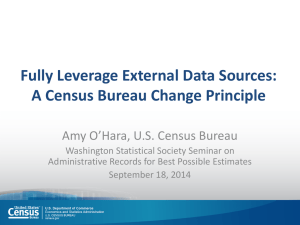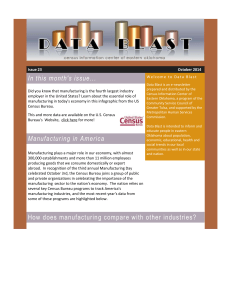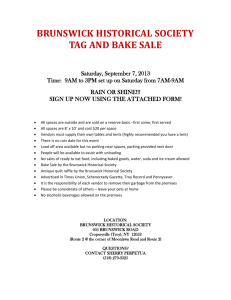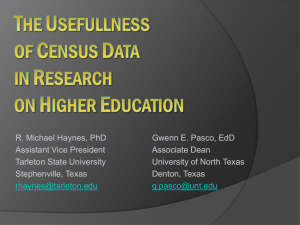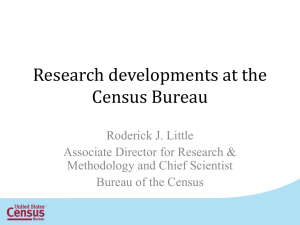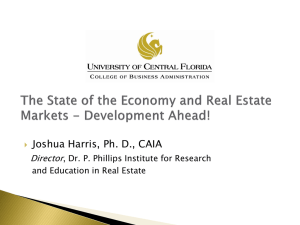Windshield Survey
advertisement
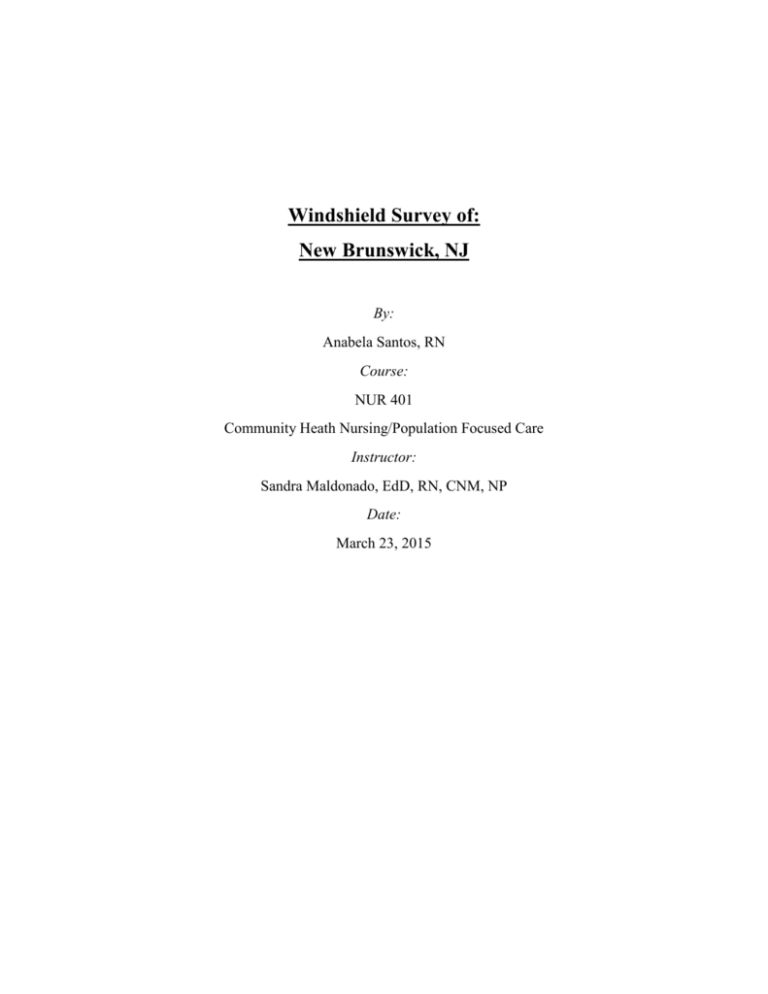
Windshield Survey of: New Brunswick, NJ By: Anabela Santos, RN Course: NUR 401 Community Heath Nursing/Population Focused Care Instructor: Sandra Maldonado, EdD, RN, CNM, NP Date: March 23, 2015 Windshield Survey The city of New Brunswick is located in Middlesex County, New Jersey. New Brunswick is the county seat of Middlesex, located in the sixth Congressional District, and part of New Jersey's seventeenth state legislative district. The city is centrally located between New York and Philadelphia. It is approximately 40 minutes southwest of New York and 45 minutes northeast of Philadelphia. According to the U.S. Census, the total area of the city is 5.789 square miles; 5.227 square miles of land and 0.562 square miles of water. With a population of 48, 573, the percentages of the gender population are exactly half male and half female. New Brunswick's climate is humid and subtropical with considerable rainfall throughout the year. There are warm and humid summers and cold winters. (U.S. Census Bureau, 2015 & City-Data.com, 2015). Housing and Zoning 42% of housing from 1960, 36% from 1970, 32% from 1980, 32%from 1990, 26% from 2000, and 24% from 2010. In the area that PRAB serves, the homes are built close together and are not maintained well. Many are in need of repair. There is little space in front and behind of homes. It appears that most homes in New Brunswick are rental properties. Mostly multifamily homes throughout, with the occasional single family homes noted closer to Rutgers University and on the boundaries of the city. The center city is noted to have a difference in real estate values compared to the outskirts of the city. (U.S. Census Bureau, 2015 & City-Data.com, 2015). Open Space Driving to New Brunswick, it appears that the city has designated an open park space and waterfront parallel to the highway. However, once in the city, there is very little open space except for the areas dedicated to hotels, Rutgers University and the Johnson and Johnson Corporation. There is not much greenery seen in the city except in these mentioned areas. Average lot sizes of homes are 100 x 30 with little to no lawns. Boundaries The Raritan River and highway Route 27 are two of New Brunswick’s borders. The city is identified as “health care city” readily displayed on signs upon entering. There are also many signs for Rutgers University. The railroad is right in the center of the city. Any industrial area is lined by the Raritan River. “Commons” There are many neighborhood hangouts which can be divided by center city (municipal and some college area), outside of center city (where my clinical site is), and various other campus areas. Center city is the busiest area. The popular George Street area is filled with pedestrians that include residents, students, hospital employees, and visitors alike. This area is central, next to the railroad and has many restaurants, theatres, bars, shops, and both local and 24 hour businesses. Outside of the center, you see more neighborhood hangouts such as Latino bodegas, small restaurants, and businesses. In campus areas you will see bookstores and businesses that cater to the Rutgers University community. Transportation 46% of people drive alone, 21% carpooled, 11% use public transportation, 14% walk, 0.90% uses bikes, and 5% use taxi or motorcycle. You can see many buses around the city especially Rutgers buses for students. There are numerous bus stops that were covered with benches. Next to my clinical site are many residents walking or using bikes, but cars do line the streets. NJ Highway 18 (exit 9 off NJ Turnpike/ Interstate 95) has many exits throughout the city. Therefore, all neighborhoods are easily accessed. Furthermore, the centralized New Brunswick Station for NJ Transit operates the Northeast Corridor Line with train service from Trenton, NJ to Penn Station, NYC. Amtrak service is available from Newark Penn Station stop or New York Penn Station last stop. (NJ Department of Labor and Workforce Development, 2011; U.S. Census Bureau, 2015, & City-Data.com, 2015). Service centers New Brunswick houses Middlesex county’s municipal buildings. There are state and federal buildings present. This is an urban center with many social agencies (Middlesex county board of social services, catholic charities, and of course my clinical site of PRAB the Puerto Rican Action Board, to say the least). Community centers serve students and the Latino community. Health care city includes many medical offices. There are churches and very small neighborhood parks. Stores There are bigger shopping centers in the center and next to the highway. Outside of center city, most people walk to neighborhood bodegas. Street people There are all types of people in the streets. Students and professors, county / municipal employees, hospital employees, residents, and visitors are all seen. Next to my clinical site, there are mostly Latinos in the streets. I did not see many animals. Signs of decay New Brunswick was a city that was seen on “its way down”. Due to the popularity of Rutgers University and the hospital area, one can note that the city is very alive and now on “its way up”. However, outside the city center, where it so happens that most of the Latino community resides, is where you see signs of decay such as: trash, abandoned cars and houses and where most of the homes need repair. Race Hispanic - 29,906 (53.4%) White alone - 13,431 (24.0%) Black alone - 7,979 (14.3%) Asian alone - 4,601 (8.2%) Two or more races - 525 (0.9%) Other race alone - 350 (0.6%) American Indian alone - 35 (0.06%) Native Hawaiian and Other Pacific Islander alone - 5 (0.01%) (City-Data.com, 2015) Ethnicity Originally New Brunswick’s Latino community consisted primarily of Puerto Ricans and Dominicans. Presently, Mexicans make up 15% of the community while Puerto Ricans and Dominicans make up 15%. Central Americans represent the rest of the Latino community. (U.S. Census Bureau, Population Division, 2015; NJ Department of Labor and Workforce Development, 2011; U.S. Census Bureau, 2015; & City-Data.com, 2015). Religion Due to the Latino community compromising 50% of the residents, the Roman Catholic religion dominates. 76% catholic, 10 % Jewish, and 14% other. (U.S. Census Bureau, Population Division, 2015; NJ Department of Labor and Workforce Development, 2011; U.S. Census Bureau, 2015; & City-Data.com, 2015). Health and morbidity It is usual to see groups of people outside a bar drinking and possibly taking part in drug use. Some residents were seen smoking cigarettes. There was a significant amount of ambulances parked outside the Emergency Departments of the hospitals. This is evident of the extensive use of healthcare. The hospital provides community outreach health fairs as evidenced by flyers posted near the hospital. At PRAB, the community was noted to be short in stature and overweight. Many expressed concerns that they are experiencing high blood pressure and elevated cholesterol levels. Most complaints consisted of body aches and pains and enormous amounts of stress. Morbidity and Mortality reports were not available for online resources. Politics There is not much evidence of political activity at this time. However, the Eagleton Institute of Politics is located outside of Rutgers University. Media Mobile phones appear to be the primary source of media. There are all types of publications available throughout the city. There is also stands for Spanish publications. References -City-Data.com. New-Brunswick-NJ. Retrieved February 21, 2015 from http://www.citydata.com/city/New-Brunswick-New-Jersey.html -PRAB. About. Retrieved February 21, 2015 from https://prab.org/about/ -Mascarenhas, R. (2011). Census data shows Hispanics as the largest minority in N.J. Retrieved February 21, 2015 from: http://www.nj.com/news/index.ssf/2011/02/census_data_shows_hispanics_as.html -NJ Department of Education. Doe data 2012-13 dropouts. Retrieved February 22, 2015 from: http://www.state.nj.us/cgi-bin/education/data/drp.pl -U.S. Bureau of Labor Statistics. Local area unemployment statistics. Retrieved February 22, 2015 from: http://www.bls.gov/lau/ -U.S. Census Bureau, Population Division. Annual estimates of the resident population: April 1, 2010 to July 1, 2013. Retrieved February 22, 2015 from: http://factfinder2.census.gov/faces/tableservices/jsf/pages/productview.xhtml?src=bkmk -NJ Department of Labor and Workforce Development. (2011). NJ labor market views. Retrieved February 22, 2015 from: http://lwd.dol.state.nj.us/labor/lpa/pub/lmv/LMV_1.pdf


